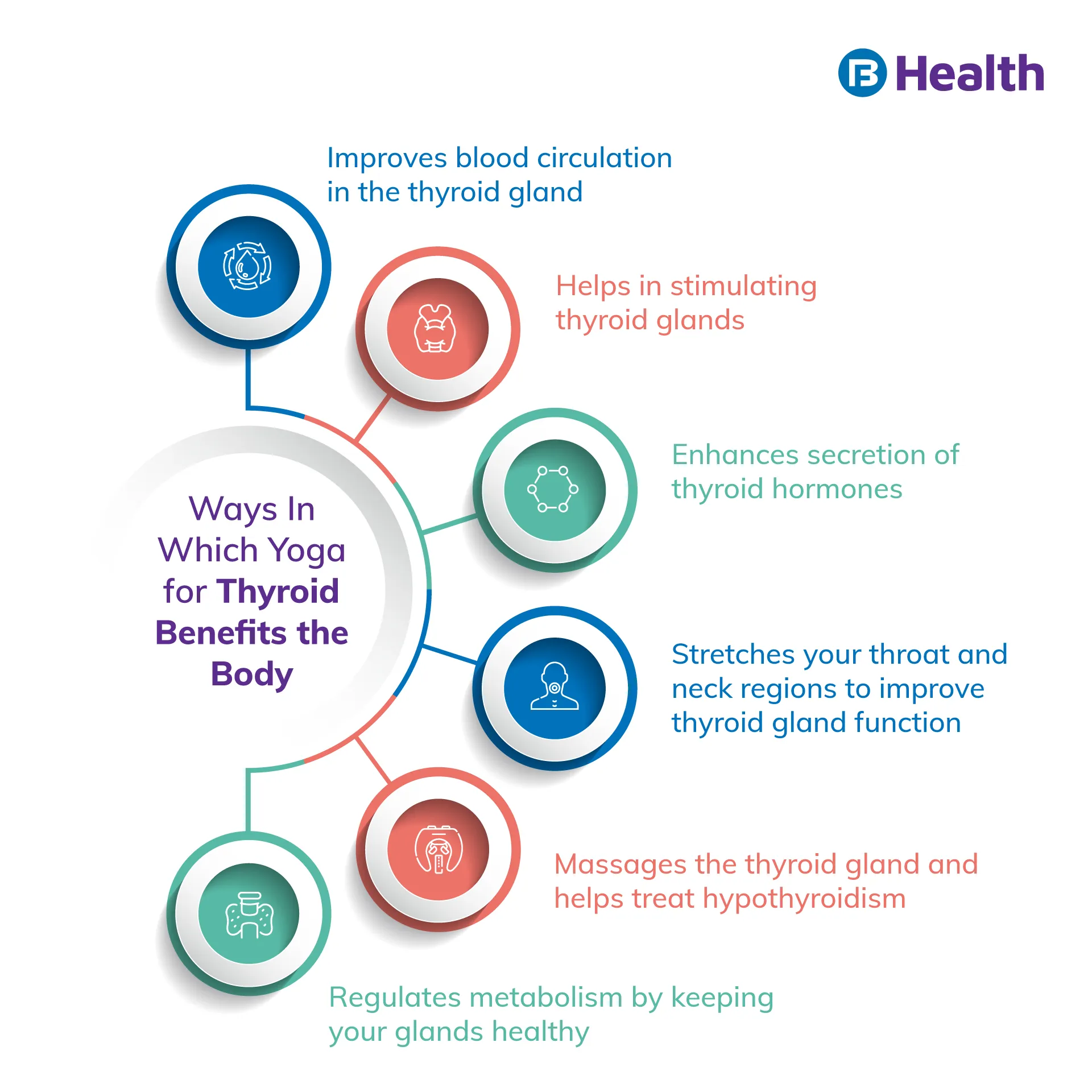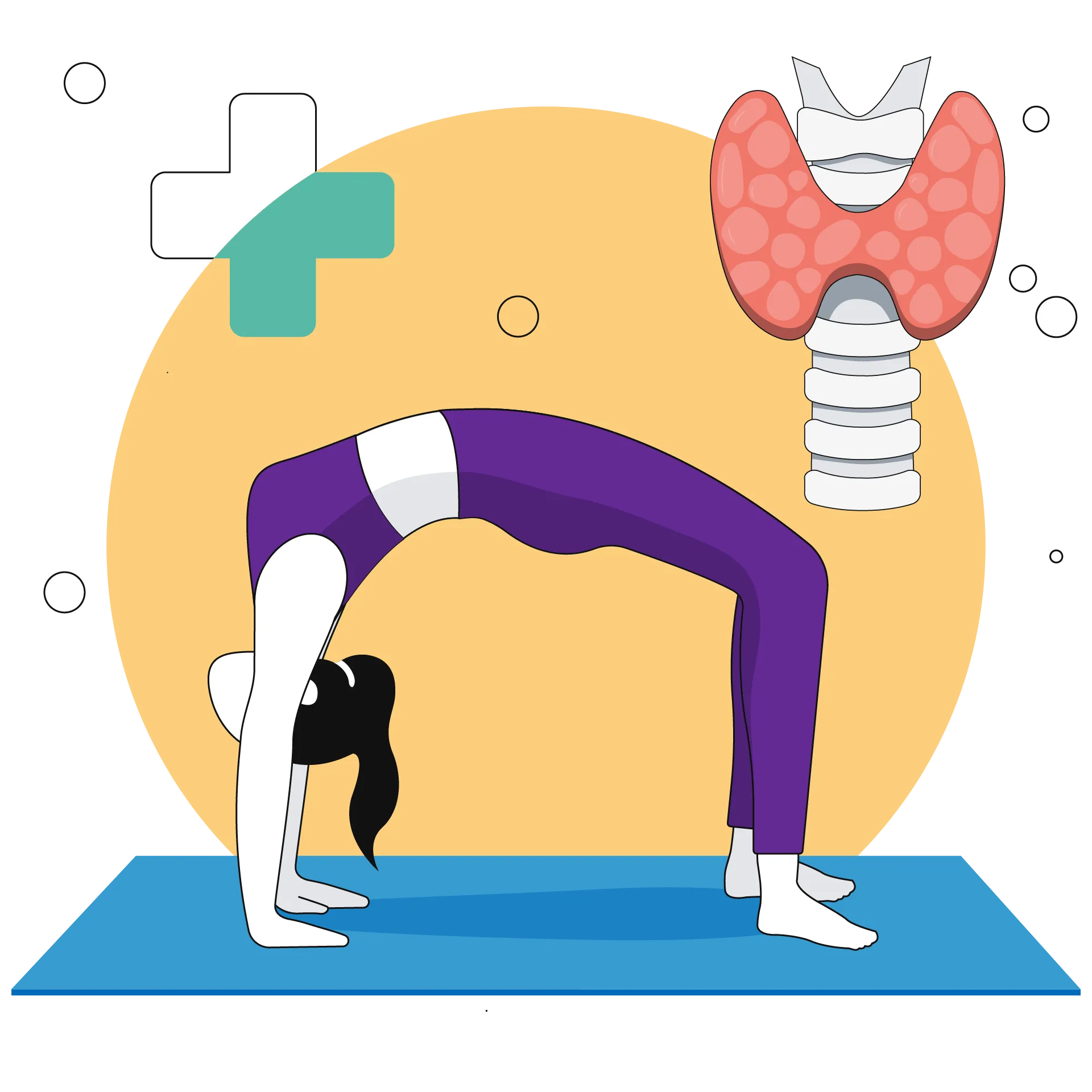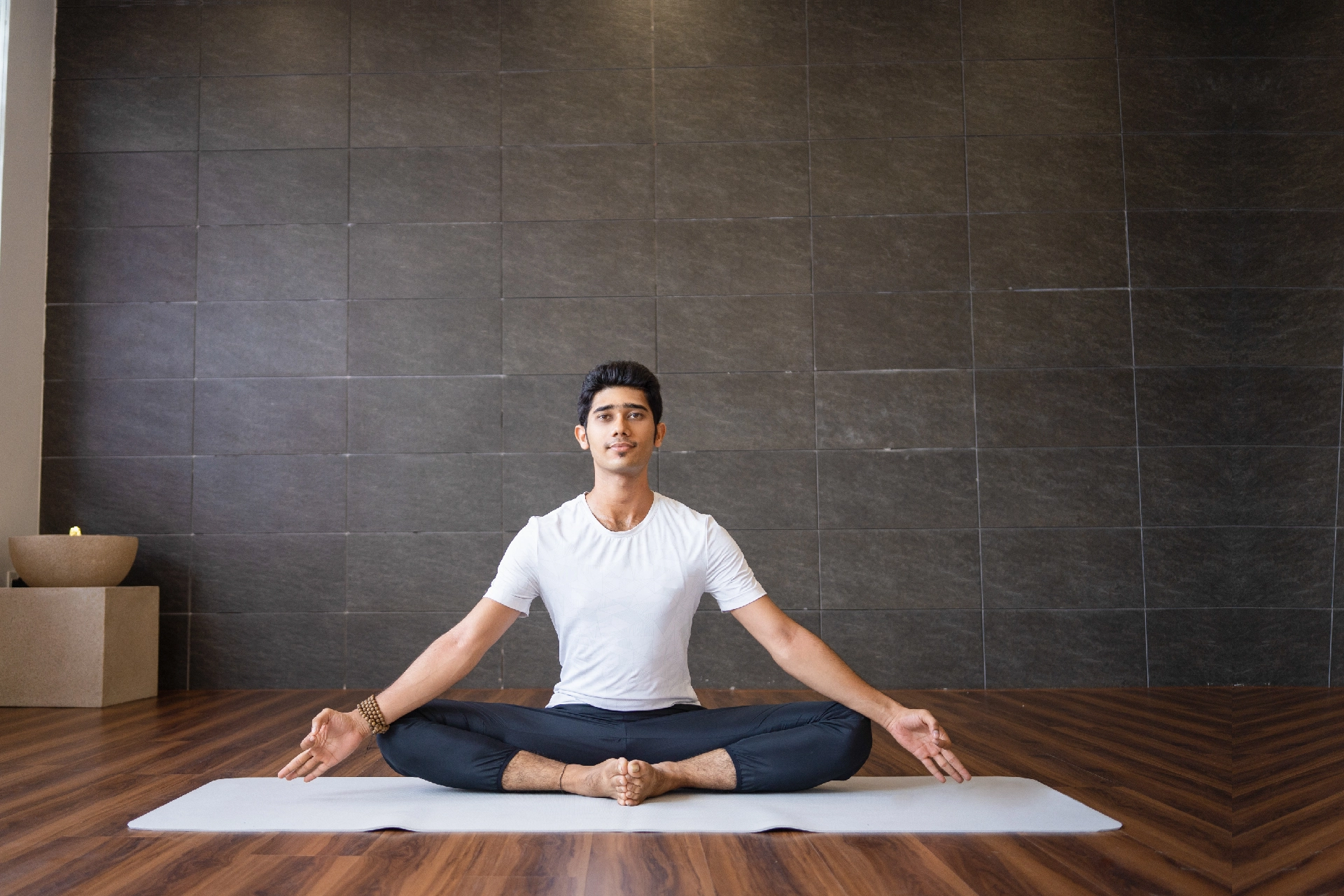Physiotherapist | 9 min read
Yoga For Thyroid: 10 Yoga For Hyperthyroidism With Easy Steps
Medically reviewed by
Table of Content
Key Takeaways
- Plough and cobra asanas are a few yoga poses for thyroid management
- Doing yoga asanas for thyroid problems stimulates proper function
- Get a thyroid test done regularly to monitor the levels of thyroid hormones
A query that many have is ‘What is thyroid disease?’ and it is important to have an answer to it because it is a common problem. The thyroid gland is a vital organ in your body responsible for producing thyroid hormones. These hormones control your body temperature, metabolism and growth. When the gland produces excess or insufficient hormones, it causes thyroid diseases. The two most common thyroid conditions are hypothyroidism and hyperthyroidism. Making minor lifestyle changes for thyroid management can help you live a healthier life. Make sure you get a thyroid test done regularly to assess if there are any problems with your thyroid gland. If these exist, practice yoga for thyroid management. Do not underestimate the importance of yoga when it comes to your physical and mental health [1]. Stress and hypothyroidism are linked, so trying different yoga for thyroid issues can help. Read on to understand more about the poses of yoga for thyroid problems.
Yoga Poses for Thyroid
Plough Pose
This pose has many benefits especially if you are suffering from hypothyroidism. Doing this asana increases the secretion of thyroid hormones in your body. Not only does the plough pose strengthen your abdominal muscles but it also relaxes your nervous system [2].
Steps To Do Plough Pose:
Follow these simple steps to do this pose.
- Lie down on your back
- Keep your arms by your side
- Inhale deeply and slowly
- Lift your legs to the sky while you inhale
- Try to touch your toes to the ground behind your head
- Provide support to your back and hips by using your arms
- Exhale slowly and return to your original position
Make sure that there are no sudden jerks while doing this pose.
Additional Read: Signs For Thyroid Hormone
Cobra Pose
Cobra pose is also a part of the surya namaskar and improves the functioning of your thyroid gland. If you are suffering from back pain, the cobra pose is the best pose for you. It is a simple asana that can be done in these steps [3].
Steps To Do Cobra Pose:
- Lie down with your stomach touching the ground
- Keep your hands near to your rib cage
- Make sure that your palms face downwards
- Apply pressure on your palms and slowly lift your upper body
- Inhale slowly when doing this
- Lift your chest, shoulders and stomach off the ground
- Avoid straightening your arms when lifting your upper body
- Stay in this position for 30 seconds and breathe normally
- Return to the original position by releasing this pose slowly
Inverted Pose
This pose is also called the legs-up-the-wall asana. It enhances the flow of blood to your thyroid gland and improves your thyroid function. The inverted pose helps fight anxiety and minimizes stress. You can do the pose in the following way.
Steps To Do Inverted Pose:
- Lie down on the ground on your back
- Place a pillow beneath your hips for support
- Lift your legs slowly against the wall
- Make sure your buttocks are placed a few inches away from the wall or against it
- Relax your chin and neck when you execute this
- Place your arms on the side of your body
- Stay in this pose for about 20 minutes
- Slowly push yourself away from the wall by releasing the pose slowly
Camel Pose
Camel pose is another effective asana for improving blood circulation to your thyroid gland. Practice this pose by following these simple steps.
Steps To Do Camel Pose:
- Be on your knees and keep your feet extended
- Make sure that your knees, shoulders and hips align
- Place your fingers on both sides of your spine
- Bring your elbows together and try opening your chest
- Make sure to press your hips and thighs in the forward direction when you are bending
- Drop your head back slowly if it is comfortable
- You can hold your ankles for support
- To release this pose, get your hands to your lower back
- Relax yourself in the child pose

Bridge Pose
Bridge Pose also known as Setu Bandhasana, this is an effective pose of yoga for hypothyroidism management. It extends your neck and improves the blood flow in the thyroid gland. To practice this pose of yoga for thyroid care, follow these steps.
Steps To Do Bridge Pose:
- Lie down on your back and bend your knees with your feet on the mat at a distance from your hips
- Move your feet closer to your upper body with your feet flat and firm on the mat
- Inhale and lift your body from your pelvic bone
- Place your hands under your back but on the mat
- Open up your collarbones and put your weight on your shoulders
- Tighten the shin at the front of your leg and move your upper thighs inward
- Further, lift your thighs and pelvis while keeping your thighs parallel to the floor
- Exhale, slowly place your hands at the side of your body, on the ground, and lower your body on the mat
- Continue breathing slowly and notice the changes in your upper body
Fish Pose
Matsyasana pose allows you to bend your head in a way that stimulates your neck and throat area. This further helps stimulate thyroid gland activity by improving the blood flow to your thyroid gland. As a result, it is among the top yoga asanas for thyroid care. To practice this asana, follow these steps.
Steps To Do Fish Pose:
- Lie face down on your mat and place your hands next to your body while keeping your feet together
- Place your hands under your back with your elbows on the mat
- Make sure your elbows are close together; if not, move them towards each other
- Inhale and slowly elevate your chest and head
- Keeping your chest and head up, slowly move your head backward to touch the floor
- Keep the pressure on your elbows and not your head
- Lift your chest from between your shoulder blades and press your legs on the floor
- Take slow breaths and hold this position for as long as you can
- Release by slowly lifting your head back up from the floor
- Gently lower your chest and head to the mat, and place your hand in their original position
Bow Pose
Known as Dhanurasana, this is one of the best poses of yoga for thyroid health. It helps your body produce the necessary thyroid hormones to control your body’s metabolism. To get the benefits of this pose of yoga for the thyroid, follow these steps.
Steps To Do Bow Pose:
- Lie down on your stomach and place your hands next to your torso with your palms facing up
- Keep your legs wide apart at the distance of your hips
- Take a deep breath and lift your legs from your hips and your upper body and arms
- Hold your ankles with your hand and maintain the distance between your legs
- At this stage, your stomach should be the only body part touching the mat
- Calmly look straight ahead and take slow breaths
- Keep your pose firm and hold it for about 30 seconds
- Finish the pose by leaving your ankles and gently lowering your body on the mat
- Let your body at rest and continue breathing for a while
Wall Pose
Viparita Karani is one of the yoga asanas for thyroid health that doesn’t put pressure on your neck. It helps regulate your thyroid function and has great benefits in managing hypothyroidism. To perform this pose, follow the steps given below.
Steps To Do Wall Pose:
- Sit while facing a wall and then lie down on your side
- Roll onto your back and gently place your legs straight and perpendicular to the wall
- Maintain a comfortable distance between your legs
- Move your tailbone towards the wall and try to touch your back to the wall
- Comfortably place your hands beside your body with your palms facing out
- Move your shoulder blades closer to each other while stretching your collarbones
- Release the tension from your body and relax completely
- Continue breathing and hold this pose for a few minutes
- To release, slowly bend your knees and roll onto your side, and stay in the position for sometime
- Gently push yourself into a sitting position by using your arm strength
Cat-Cow Pose
This yoga for the thyroid activates your throat chakra and regulates your blood flow in the area. It stretches your neck and benefits your thyroid gland. Follow these steps to regularly practice this pose of yoga for the thyroid.
Steps To Do Cat-Cow Pose:
- Begin getting on all fours like a cat; the pose will also resemble a tabletop
- Keep your palms parallel to your shoulders and your knees parallel to your hips
- Take a deep breath and push your spine towards the ceiling while pressing down on your palms
- Touch your chin to the chest while looking at your nose
- Hold the pose for a few seconds
- Exhale and push your spine towards the mat while looking up and stretching your neck
- Hold the pose for a few seconds
- Keep repeating the inhale and exhale postures for a few minutes
- Keep your arms straight and shoulders relaxed at all time
- After the last exhale, come back to the original pose and relax for a few seconds
Corpse Pose
Shavasana is one of the most common and beneficial yoga poses. It also stimulates activity in your thyroid without being as intense as other yoga asanas for the thyroid. It helps in managing thyroid activity by helping your body relax and regulate blood circulation. To practice this pose of yoga for hypothyroidism and hyperthyroidism, follow the steps given below.
Steps To Do Corpse Pose:
- Lie down on your mat and completely relax your body
- Keep your legs separate and let your hands fall on either side of your body
- Maintain a distance between your arms and torso
- Gently take support from your shoulder blades by contracting them
- Once you get into a comfortable position, release all the tension from your body
- Your body may feel heavy, let that be and try breathing naturally
- Keep your mind calm and stress-free; if your mind wavers, then gently focus on your breathing
- Maintain this posture for a couple of minutes and stay relaxed and focused
- Bring your arms above your head, your knees to your chest
- Slowly roll to your side and get up to finish the pose
Whether you are practicing yoga asanas for hypothyroidism or yoga poses for hyperthyroidism, be consistent. While doing yoga may not eliminate your thyroid issues, it can boost the functioning of this gland. For more help, you can consult with top endocrinologists on Bajaj Finserv Health. Book an in-person or online doctor consultation within minutes and get your thyroid symptoms addressed on time.
References
- http://nopr.niscair.res.in/handle/123456789/42288
- http://www.ijpehss.org/admin/image/b4947659ffeee4a3298858bb88a7e1f41561055866546.pdf
- https://www.artofliving.org/in-en/yoga/yoga-poses/cobra-pose-bhujangasana
Disclaimer
Please note that this article is solely meant for informational purposes and Bajaj Finserv Health Limited (“BFHL”) does not shoulder any responsibility of the views/advice/information expressed/given by the writer/reviewer/originator. This article should not be considered as a substitute for any medical advice, diagnosis or treatment. Always consult with your trusted physician/qualified healthcare professional to evaluate your medical condition. The above article has been reviewed by a qualified doctor and BFHL is not responsible for any damages for any information or services provided by any third party.




